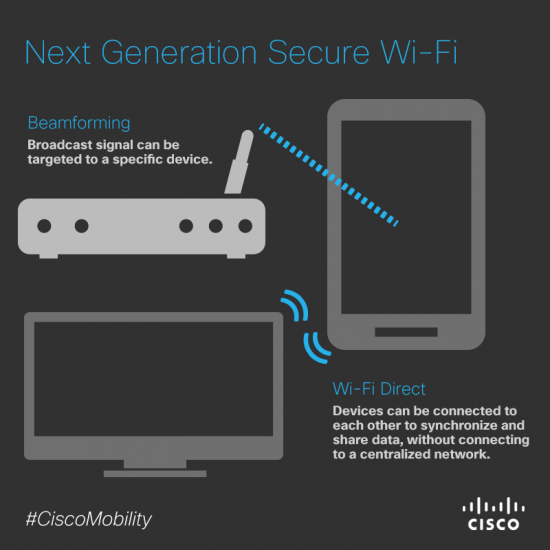































With the adoption of the Internet of Things and Internet of Everything, advances in mobility and next-generation Wi-Fi are driving faster speeds, higher signal quality and more reliable connectivity. With the upcoming ratification of the two waves of the 802.11ac Wi-Fi standard, how are emerging Wi-Fi models creating new security features that are defining the next-generation Wi-Fi experience?
Next Generation Wi-Fi Models
Migration to the 5 GHz-only 802.11ac is quickly becoming a reality. In a recent article by Lisa Phifer, Chris Spain, Vice President of Product Marketing for Cisco's Wireless Networking Group, discusses more about how this migration will drive a shift in mobile device support for 5 GHz. "An increasing percentage of new mobile devices provide dual-band capability, and they generally prefer the less congested 5 GHz band," Spain said. New Wi-Fi models, like those listed below, can help drive mobile devices to the 5GHz band:

The Value of Secure Wi-Fi
As more people connect to both wired and wireless networks via smart phones, tablets and laptops, security will continue to be a top concern. As mobility trends such as the proliferation of devices and increased data and video traffic drive new expectations from networks, a strategic and architectural approach to secure mobility is essential.
When next-gen Wi-Fi can deliver faster speeds and media-rich publishing platforms, the future of mobility can be better realized. For example, new revenue generating opportunities such as location-based services and marketing information can be delivered in a controlled and opt-in environment. Some examples include:
This is the value of secure Wi-Fi, and increased mobility is making it possible. Be sure to download and read the Cisco 2013 Annual Security Report, which includes real-world data and analysis that can help you update and strengthen your security strategy.
How do you think mobility is driving the future of secure Wi-Fi networks? Let us know via comment below or join the conversation on Twitter,#CiscoMobility.
 Tags quentes :
Mobilidade
#Segurança
rede
Wi-Fi
wireless
connected mobile experiences
11ac
future of mobility
CiscoMobility
Tags quentes :
Mobilidade
#Segurança
rede
Wi-Fi
wireless
connected mobile experiences
11ac
future of mobility
CiscoMobility